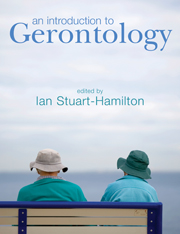Book contents
- Frontmatter
- Contents
- List of figures
- List of tables
- List of contributors
- 1 Introduction
- 2 The biology of ageing
- 3 Fostering resilience, promoting health and preventing disease in older adults
- 4 Ageing and health
- 5 Social care and older people
- 6 Cognitive processes and ageing
- 7 The psychology of atypical ageing
- 8 Sociological perspectives on ageing
- 9 Retirement
- 10 Sexuality and ageing
- 11 Policies on ageing
- 12 Cross-cultural differences in ageing
- 13 Technology and ageing
- 14 Literary portrayals of ageing
- 15 Palliative care for older adults
- 16 Conclusions
- Index
- References
15 - Palliative care for older adults
Published online by Cambridge University Press: 05 June 2012
- Frontmatter
- Contents
- List of figures
- List of tables
- List of contributors
- 1 Introduction
- 2 The biology of ageing
- 3 Fostering resilience, promoting health and preventing disease in older adults
- 4 Ageing and health
- 5 Social care and older people
- 6 Cognitive processes and ageing
- 7 The psychology of atypical ageing
- 8 Sociological perspectives on ageing
- 9 Retirement
- 10 Sexuality and ageing
- 11 Policies on ageing
- 12 Cross-cultural differences in ageing
- 13 Technology and ageing
- 14 Literary portrayals of ageing
- 15 Palliative care for older adults
- 16 Conclusions
- Index
- References
Summary
OVERVIEW
In modern industrialized societies, the experience of death is often preceded by lengthy illness. This chapter therefore commences with a study of palliative care and key aspects, including pain and symptom management and advance care planning. It proceeds to examine caregiver burden and settings of care before a final section on grief and bereavement.
Introduction
Any textbook on gerontology would not be complete without a chapter on the topic of death, dying and bereavement. Indeed, that was the intended title of this section of the book. However, a brief discussion of the context in which many older adults live today, and eventually die, will help explain the alternative title as it appears above.
In 1900, the leading causes of death in the USA were pneumonia, tuberculosis and intestinal infections. This pattern was true across much of the developed world. These three diseases are all infectious, all resulted in rapid death due to lack of effective treatments, and all affected individuals of all ages. With modern advances, first in sanitation and later in antibiotics and other medical treatments, some people with these ailments survived and others were prevented from contracting the illnesses in the first place. One of the consequences of these advances is what Robert Butler (2008) has coined the longevity revolution.
- Type
- Chapter
- Information
- An Introduction to Gerontology , pp. 416 - 429Publisher: Cambridge University PressPrint publication year: 2011

